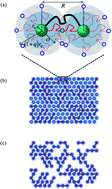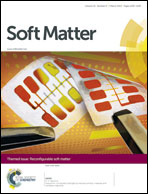Modeling polymer grafted nanoparticle networks reinforced by high-strength chains†
Abstract
Using a multi-scale computational approach, we determine the effect of introducing a small fraction of high-strength connections between cross-linked nanoparticles. The nanoparticles' rigid cores are decorated with a corona of grafted polymers, which contain reactive functional groups at the chain ends. With the overlap of neighboring coronas, these reactive groups can form weak labile bonds, which can reform after breakage, or stronger bonds, which rupture irreversibly and thus, the nanoparticles are interconnected by dual cross-links. We show that this network can be reinforced by the addition of high-strength connections, which model polymer arms bound together by bonds with energies on the order of 100 kBT. We demonstrate that in the course of these simulations, these high-strength connections can be treated as unbreakable chains. By subjecting networks with a random distribution of the unbreakable chains to tensile deformation at a constant strain-rate, we determine the distribution of strain at break and toughness. With even a small amount of unbreakable chains, the nanoparticle networks can survive strains far greater than the networks without these connections. Furthermore, networks containing the high-strength connections tend to form long, thin threads, which enable a larger strain at break. The findings provide guidelines for creating polymer grafted nanoparticles networks that could show remarkable strength and ductility.

- This article is part of the themed collection: Reconfigurable soft matter

 Please wait while we load your content...
Please wait while we load your content...